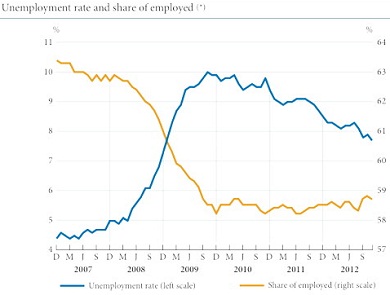The fact is that there are two reasons for wanting growth to be maintained: to assist both private sector deleveraging and the recovery in employment. Regarding growth, the ratio resulting from dividing outstanding household debt by disposable household income has fallen further, more because of the rise in disposable income than any reduction per se in outstanding debt. This ratio fell from a peak of 129.3% in September 2007 to 107.7% in September 2012, a drop of 21.6 percentage points. If, disposable income had remained constant in this period instead of increasing by 14.0%, the ratio would have ended up at 122.7%, a drop of just 6.5 percentage points.
The US labour market is recovering more slowly than in previous cycles. This develops into higher long-term unemployment, which accounts for 40.1% of the total, and a low participation rate due to discouraged people leaving the job market. The risk is that this low share of employed within the population aged over 16, already at 58.7%, may crystallize. In turn, this would end up reducing average growth over the coming years.
In the short term, November’s employment figures were better than expected with 146,000 net jobs created and the unemployment rate falling by 0.2 percentage points to 7.7%. But the drop in the unemployment rate was still based on under par growth in the labour force, the people who are working or looking for work, with the participation rate falling by 0.2 percentage points to 63.6%. Should the trend of the last three months continue, we will have to wait until the end of 2015 to see a full recovery in employment.
Given this need to underpin growth, in November the Fed officially announced its intention to incorporate the unemployment rate as a target to guide its monetary policy. This means that, until unemployment falls below 6.5%, interest rates will remain at a minimal level and debt purchases will continue at an initial rate of 85 billion dollars a month.
All this, providing the long-term level of inflation, in other words core inflation, does not exceed 2.5%, which is what the Fed expects. The recent trend in prices has therefore given it considerable room to manoeuvre. The consumer price index (CPI) rose by 1.8% year-on-year in November, 2.2% in October, due to base effects from the price of the energy bill, while the core CPI, the general index without energy or foods, remained moderate, rising 1.9% in November, 2.0% in October.
The low utilization of production capacity will ensure inflationary tensions remain absent in 2013 in spite of the possible erratic performance of commodity prices.
In the short term, the latest indicators point to the effects of Hurricane Sandy being more limited than expected but, at the same time, uncertainty has increased due to the lack of agreement regarding fiscal adjustment.
Retail sales were surprisingly high in November, indicating the good tone of purchases during the Thanksgiving campaign, and the indicator reflecting the underlying trend for retail activity, which excludes automobiles and petrol, picked up in November with an advance of 5.7% year-on-year. Automobile sales also recovered after their stagnation in October. In November, industrial production had its best month for the last two years, offsetting the declines in October and pointing to a satisfactory recovery in production chains.







Be the first to comment on "US unemployment rate improves, but does job creation?"